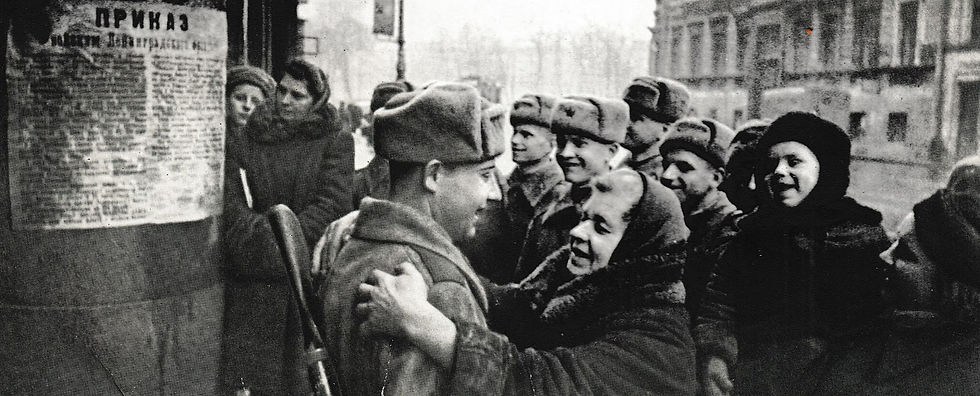Leningrad: A photographic exposition of resistance, victory and reconstruction
- Michael Laxer
- Jan 27, 2021
- 2 min read
On January 27, 1944 the Red Army finally lifted the siege of Leningrad. These contrasting images of the city during the days of the war and in peacetime tell an incredible tale of struggle, resistance, victory and rebirth.

A poster proclaiming that "The Blockade Has been Lifted!" is put up in Leningrad /
Kindergarten students taking a walk past the same spot in 1980
On January 27, 1944 the Red Army finally lifted the siege of Leningrad.
Leningrad was, of course, under siege by Nazi forces for a staggering 872 days. It heroically resisted despite constant encirclement, bombardment and mass starvation in the first winter. It is believed that over a million citizens of the city lost their lives. It is regarded as the deadliest siege in history.
The Soviets found ways to get supplies into and people out of the city across Lake Ladoga via ice roads in winter and shipping in summer. The courage of the men and women who made these incredibly dangerous runs to keep the city alive was astonishing. Many were killed or wounded.
While a narrow land corridor into the city was opened in January, 1943, the siege itself was not broken until January 27, 1944.
After the siege much of the city was in ruins as were a great number of the cities of the USSR. It was, however, rebuilt in the postwar years as was the rest of the Soviet Union. The story of this rebuilding is remarkable and what was accomplished can be seen seen in leaflets like "USSR - Facts and Figures 1982".
This powerful and moving postcard folder was published in the USSR in 1980 and shows "before and after" photographs of locations in Leningrad during the Second World War and after reconstruction and peace.
The tremendous and justified pride felt about the defeat of the Nazi as well as the central role this almost unbelievable collective trauma played in the Soviet narrative about themselves come through in these photos of struggle, resistance, victory and rebirth.
Here are the postcards with the before / after text from the back.




Red Army men on their way to the front /
The archway of the former building of the General Staff on a festive night

The Bronze Horseman sheltered from the bombs /
Decembrists Square 1980

Detachment of the civilian military training organization in Ostrovsky Square /
Ostrovsky Square in autumn 1980

Observation post on the roof /
St. Issac's Square

Self-propelled guns on the way to the front /
Stachek Square 1980

House No. 174 in the Nevsky Prospekt destroyed by a bomb /
No signs of the war! 1980

The ruins of the Pulkovo Observatory/
The Pulkovo Observatory 1980

The blockade has been lifted! /
Kindergarten students taking a walk past the same spot
(I find this one particularly moving)

Victory Parade /
Demonstration of November 7, 1967

Patrol of Soldiers /
Vasilyevsky Island Spit with drifting ice

The people of Leningrad had not seen the equestrian statues of the Anichkov Bridge for three years/
"Horse Tamer" on the bridge again

Lenin Square, Monument to Lenin safely protected from bombs and shrapnel /
Lenin Square today -- one of the most beautiful squares of the town

Barrage balloons /
A girl selling air balloons

The blockade dead /
Monument on the common grave of the defenders of Leningrad

January 27, 1944 -- The day the blockade was lifted /
Festive salvo of remembrance

Isn't it sad, after all suffering, USSR collapsed under the Stalinism due to the alienation from the working class. Stalinism is cruel, treacherous. At the end the loser is the humanity!